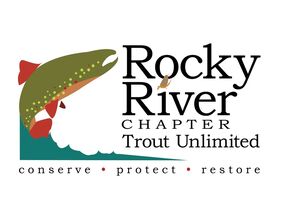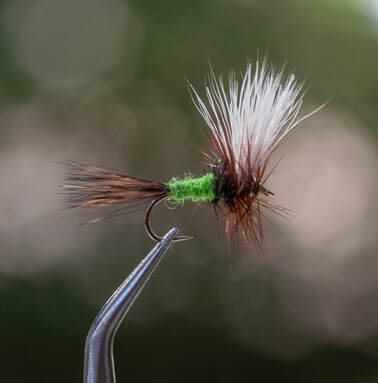Green Gremlin
Fly of the Month
In the Southern Appalachians, there are many insect green “bugs” that are found under the canopy, in our wooded headwater streams. Little green stoneflies during the summer, katydids during all the warmer months, aphid clusters and inchworms. The insect green or chartreuse color works well to suggest any of these “bugs” that might end up floating down the stream.
The adoption of the hairwing fly patterns that eventually became the Wulff dry fly style began in the late 1920s in several locations. In the Southern Appalachians, some of the earliest hair wing fly patterns include the Green Gremlin. This fly pattern pre-dates the Wulff series and is considered the predecessor of the Tennessee Wulff which is essentially a version of the Royal Wulff except with a green floss body.
Green Gremlin
Walter Babb knew exactly what a Green Gremlin was when we called him to solve a puzzling set of Fred Hall flies. The Green Gremlin was one of fifty-eight Fred Hall fly patterns that were framed by Teddy Greene as a keepsake. He grew up in Bryson City, North Carolina as a huge fan of Fred Hall. Some of the flies, including the Green Gremlin were damaged by moths. Subsequently, the collection of fly patterns has been fully restored for display in the Fly Fishing Museum of the Southern Appalachians.
The Green Gremlin has a peacock herl collar just behind the upright and divided wings, much like Spruce fly. This is a more ancient body design and most likely one of many hair wing designs of that period that were independently created by fly tyers of the day.
To fly-fish the Green Gremlin, care must be taken to apply silicone-gel floatant and allow to dry for maximum floating capability. A size 16 version is a good imitation of the little green stoneflies that appear during the summer on our freestone mountain trout streams. A large size 12 version is a good imitation of a katydid or green June bug. Fly-fish the Green Gremlin like any dry fly, best presented as a dead drift with no drag.
There is also a Green Gremlin Streamer that was originated by Jim Pelletier. This streamer is a totally different fly pattern, but independently named.
Green Gremlin
Fly of the Month 11.18
Tom Adams and Alen Baker
Green Gremlin
Hook : Dry Fly, 1x long, size 10, 12, 14, 16, Tiemco 100 or equivalent
Thread : 8/0 Uni or equivalent in Black
Tail : Deer belly
Body : Peacock Herl and Green Dubbin
Wing : Calf Tail
Hackle : Coachman Brown rooster
Directions :
- Tom Adams, Alen Baker
In the Southern Appalachians, there are many insect green “bugs” that are found under the canopy, in our wooded headwater streams. Little green stoneflies during the summer, katydids during all the warmer months, aphid clusters and inchworms. The insect green or chartreuse color works well to suggest any of these “bugs” that might end up floating down the stream.
The adoption of the hairwing fly patterns that eventually became the Wulff dry fly style began in the late 1920s in several locations. In the Southern Appalachians, some of the earliest hair wing fly patterns include the Green Gremlin. This fly pattern pre-dates the Wulff series and is considered the predecessor of the Tennessee Wulff which is essentially a version of the Royal Wulff except with a green floss body.
Green Gremlin
Walter Babb knew exactly what a Green Gremlin was when we called him to solve a puzzling set of Fred Hall flies. The Green Gremlin was one of fifty-eight Fred Hall fly patterns that were framed by Teddy Greene as a keepsake. He grew up in Bryson City, North Carolina as a huge fan of Fred Hall. Some of the flies, including the Green Gremlin were damaged by moths. Subsequently, the collection of fly patterns has been fully restored for display in the Fly Fishing Museum of the Southern Appalachians.
The Green Gremlin has a peacock herl collar just behind the upright and divided wings, much like Spruce fly. This is a more ancient body design and most likely one of many hair wing designs of that period that were independently created by fly tyers of the day.
To fly-fish the Green Gremlin, care must be taken to apply silicone-gel floatant and allow to dry for maximum floating capability. A size 16 version is a good imitation of the little green stoneflies that appear during the summer on our freestone mountain trout streams. A large size 12 version is a good imitation of a katydid or green June bug. Fly-fish the Green Gremlin like any dry fly, best presented as a dead drift with no drag.
There is also a Green Gremlin Streamer that was originated by Jim Pelletier. This streamer is a totally different fly pattern, but independently named.
Green Gremlin
Fly of the Month 11.18
Tom Adams and Alen Baker
Green Gremlin
Hook : Dry Fly, 1x long, size 10, 12, 14, 16, Tiemco 100 or equivalent
Thread : 8/0 Uni or equivalent in Black
Tail : Deer belly
Body : Peacock Herl and Green Dubbin
Wing : Calf Tail
Hackle : Coachman Brown rooster
Directions :
- Wrap thread one third back from eye, starting one to two eye lengths from eye, let bobbin hang
- Select calf tail hair and cut. Clean underfur thoroughly and stack in hair stacker. Tap several times and remove with right hand, pinching the tips between the index finger and thumb, maintain alignment. Place calf tail on top of the hook, with the length to be tied in, about the same length as the hook shank. Wrap softly at the one third back mark and release the grip with the right hand. The wraps should be very close together working toward the hook bend. This is only to position and judge the height of the wings. Once you are happy with the wings, tie in firmly and trim the hair making a diagonal cut. Now the calf tail can be secured by binding the diagonal with firm wraps. Advance the thread immediately forward of the hair and lifting the bundle of hair on the top of the shank with your left hand, pull the thread against the base of the tie in, on top of the shank and pull the thread away and toward the hook bend. When you pull the thread in a straight and parallel (to the hook shank) fashion the hair will stand straight up. Make several turns immediately in front of the hair. Take the thread and divide the upright hair clump into two fairly even sections. Use a figure eight wrap to divide and shape the wings. Once secure take the thread to behind the diagonal cut of the hair (the hair on top of the hook should be pretty well covered by thread now) and let the bobbin hang
- Select a clump of deer and clean for the tail and tie in on top of the hook shank. Length should be about the same as the hook shank.
- Dub with green dubbing and advance the dub to the thorax in tight touching turns. Let the bobbin hang.
- Wrap the peacock herl about three wraps, leaving enough room for the hackle and secure. Trim any excess and let the bobbin hang.
- Choose a Coachman brown rooster hackle with barbs about one and one half the width of the hook gape. Expose about a one quarter inch of stem and tie in behind the wing, trimming any excess. The hackle “shiny “ side should be facing the eye. Advance the thread to in front of the wing and let the bobbin hang. Begin wrapping the hackle in tight and touching turns. About three wraps behind the wing and three wraps in front. Leaving sufficient room for the head, tie in and trim excess. Form a head, and apply head cement.
- Tom Adams, Alen Baker

